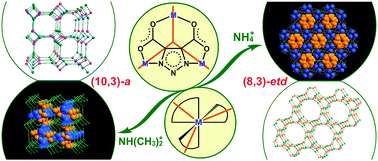Three new chiral metal–organic frameworks, (H2NMe2)[M(tzdc)]·0.5H2O [M![[double bond, length as m-dash]](https://www.rsc.org/images/entities/char_e001.gif) Co(II) (1), Mn(II) (2)] and (NH4)[Mn(tzdc)]·2.6H2O (3) (tzdc3− = 1,2,3-triazole-4,5-dicarboxylate), have been solvothermally synthesized. In the frameworks of 1–3, the ratio of metal and tzdc3− is 1 : 1. Each metal ion is chelated by three tzdc3− ligands, and each tzdc3− connects three metal ions, resulting in three-dimensional, 3-connected anionic frameworks. 1 and 2 are isomorphous, and both crystallize in the cubic space groupP213. With the template of H2NMe2+ cations, the frameworks of 1 and 2 have a well-known, porous (10,3)-a network. In contrast, 3 can be obtained by replacing the H2NMe2+ with smaller NH4+ cations, which leads to a significant topological change to a unique uniform etd (8,3) network as well as the change of the space group to P61. Magnetic studies show dominated antiferromagnetic interactions in 1–3 with θ = −46.8(1), −22.3(1) and −25.8(1) K for 1, 2 and 3, respectively. Due to the triangular arrangement of the metal centres, geometrically spin-frustrated magnetism is a characteristic behaviour of 1–3. For 1, spin-glassy behaviour with a freezing temperature Tf of 2.4 K was distinctly observed, and an empirical factor f = |θ |/Tf ≈ 20 > 10 indicates strong spin-frustration effect. For both 2 and 3, no obvious long-range magnetic ordering and/or spin–glassy behaviour was observed down to 2.0 K, which might indicate the f values in them being also larger than 10. By contrast, the observed spin-glassy behaviour above 2.0 K in 1 is probably due to the stronger magnetic anisotropy of Co(II) ion and the stronger antiferromagnetic interactions in 1.
Co(II) (1), Mn(II) (2)] and (NH4)[Mn(tzdc)]·2.6H2O (3) (tzdc3− = 1,2,3-triazole-4,5-dicarboxylate), have been solvothermally synthesized. In the frameworks of 1–3, the ratio of metal and tzdc3− is 1 : 1. Each metal ion is chelated by three tzdc3− ligands, and each tzdc3− connects three metal ions, resulting in three-dimensional, 3-connected anionic frameworks. 1 and 2 are isomorphous, and both crystallize in the cubic space groupP213. With the template of H2NMe2+ cations, the frameworks of 1 and 2 have a well-known, porous (10,3)-a network. In contrast, 3 can be obtained by replacing the H2NMe2+ with smaller NH4+ cations, which leads to a significant topological change to a unique uniform etd (8,3) network as well as the change of the space group to P61. Magnetic studies show dominated antiferromagnetic interactions in 1–3 with θ = −46.8(1), −22.3(1) and −25.8(1) K for 1, 2 and 3, respectively. Due to the triangular arrangement of the metal centres, geometrically spin-frustrated magnetism is a characteristic behaviour of 1–3. For 1, spin-glassy behaviour with a freezing temperature Tf of 2.4 K was distinctly observed, and an empirical factor f = |θ |/Tf ≈ 20 > 10 indicates strong spin-frustration effect. For both 2 and 3, no obvious long-range magnetic ordering and/or spin–glassy behaviour was observed down to 2.0 K, which might indicate the f values in them being also larger than 10. By contrast, the observed spin-glassy behaviour above 2.0 K in 1 is probably due to the stronger magnetic anisotropy of Co(II) ion and the stronger antiferromagnetic interactions in 1.
![[double bond, length as m-dash]](https://www.rsc.org/images/entities/char_e001.gif) Co(II) (1), Mn(II) (2)] and (NH4)[Mn(tzdc)]·2.6H2O (3) (tzdc3− = 1,2,3-triazole-4,5-dicarboxylate), have been solvothermally synthesized. In the frameworks of 1–3, the ratio of metal and tzdc3− is 1 : 1. Each metal ion is chelated by three tzdc3−
Co(II) (1), Mn(II) (2)] and (NH4)[Mn(tzdc)]·2.6H2O (3) (tzdc3− = 1,2,3-triazole-4,5-dicarboxylate), have been solvothermally synthesized. In the frameworks of 1–3, the ratio of metal and tzdc3− is 1 : 1. Each metal ion is chelated by three tzdc3− 

 Please wait while we load your content...
Please wait while we load your content...